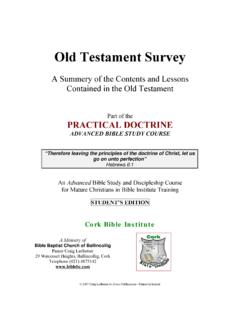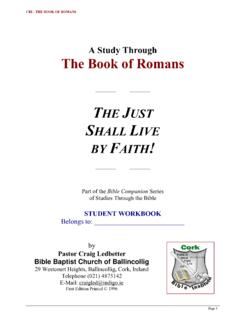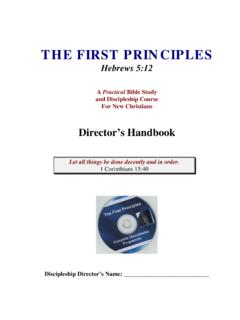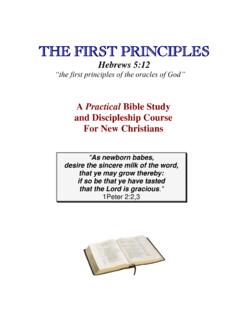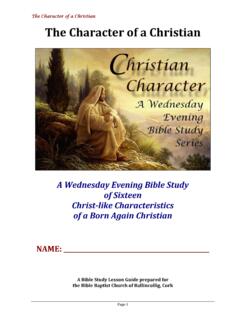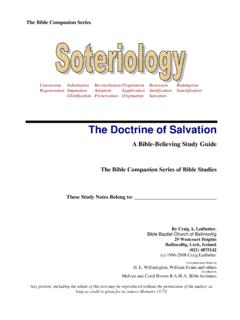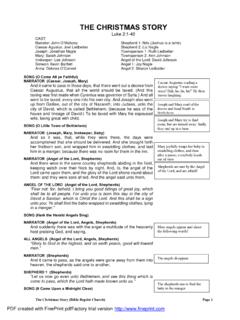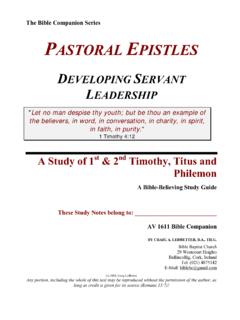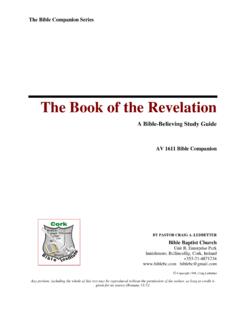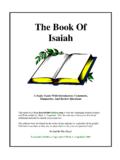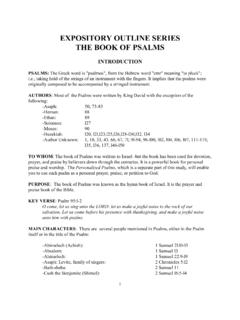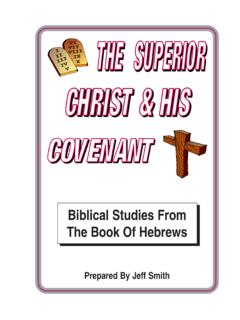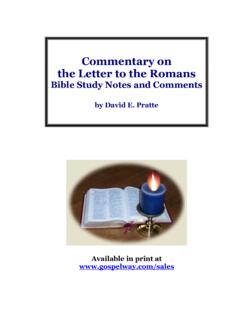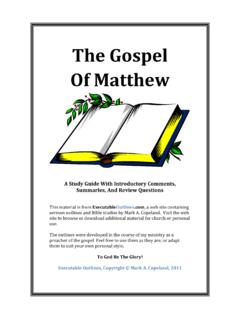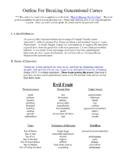Transcription of Overview of the New Testament - Student
1 Overview of the New Testament Student Edition A Basic Survey of the Background and Teaching of the Entire New Testament Cork Bible Institute Course By Craig A. Ledbetter, , Bible Baptist Church of Ballincollig 29 Westcourt Heights Ballincollig, Cork, Ireland Tel: (021) 4875142 E-Mail: Overview of the New Testament COURSE REQUIREMENTS Cork Bible Institute 2007 Page 2 TABLE OF CONTENTS COURSE BRIEF Overview OF THE NEW BRIEF BIOGRAPHY OF EACH THE LANGUAGE OF THE NEW Map of Palestine at the Time of Detailed Overview of the New Testament The Gospel of general Outline of The Gospel of The Gospel of The Gospel of Harmony of the The Book of 1 2 1 2 1 2 1 2 1 2 3 The Overview of the New Testament Final Overview of the New Testament COURSE REQUIREMENTS Cork Bible Institute 2007 Page 3 COURSE REQUIREMENTS A.
2 Attend 8 of the 11 weeks this course is run. Any more misses than that and your status will be reduced to that of Auditor and will have to retake the course, unless special arrangements are made. B. Read through the entire New Testament by the Final Exam just before Christmas that means reading 4 chapters a day. C. Summarize the contents of one of the books of the New Testament preferably, your favourite book. Turn in this report at the Final Exam. INTRODUCTION The New Testament consists of ___ books. The word " Testament " generally means a "_____, agreement, contract". "New" is used as in contrast to the "Old" Testament , or the way God related to men and women after the coming of Christ. Someone once said, we should simply title the Bible _____ _____. The "Old" Testament would be, Volume One: The Plan Begins.
3 And the "New" Testament would be called Volume Two: The Plan Completed. The Purpose of the New Testament : _____, as the fulfilment of Old Testament history, ceremony and prophecy. The New Testament is divided into _____ sections: the Gospels (Matthew through John), history (the book of Acts), the Pauline Epistles (Romans through Hebrews), the general Epistles (James through Jude), and prophecy (the book of Revelation). The New Testament was written from approximately 50 to approximately 95. The New Testament was written in Koine Greek (common Greek, the everyday form of the Greek language in the first century ) A. The Gospels give us _____ different, yet not conflicting, accounts of the birth, life, ministry, death, and resurrection of Jesus Christ. They demonstrate how Jesus was the promised Messiah of the Old Testament and they lay the foundation for the teaching of the rest of the New Testament .
4 B. The book of Acts records the deeds of Jesus' apostles, the men Jesus sent out into the world to proclaim the Gospel of salvation. It also tells us of the beginning of the _____ and its rapid growth in the first century C. The Pauline Epistles, written by the Apostle Paul, are letters usually written to specific churches - giving official Christian doctrine and the practice that should follow that doctrine. D. The general Epistles compliment the Pauline Epistles with additional teaching and application, especially directed at the _____. E. The book of Revelation prophesies the events that will occur in the end times. A survey of the New Testament is a powerful and rewarding study. The New Testament tells us of Jesus' death on the cross on our behalf - and what our response should be to His death.
5 The New Testament focuses on giving solid Christian teaching along with the practical results that should follow that teaching. Overview of the New Testament BRIEF Overview OF THE NEW Testament Cork Bible Institute 2007 Page 4 BRIEF Overview OF THE NEW Testament Biography History Pauline Epistles general Epistles Prophecy Matthew Mark Luke John Acts Romans 1 Corinthians 11 Corinthians Galatians Ephesians Phillipians Colossians 1 Thessalonians 11 Thessalonians 1 Timothy 11 Timothy Titus Philemon Hebrews James 1 Peter 11 Peter I John II John III John Jude Revelation I. The Gospels: _____. The Gospels were written to tell us about Christ's ministry (His doings and teachings) with a special focus on His birth and death. (Note how much space is devoted to the last week of His life.) They are divided into two sections: the Synoptic gospels (Matthew, Mark, and Luke--which share much of the same material) and the fourth gospel, the Gospel of John.
6 Why are there so many gospels? The law required two or three witnesses to establish a fact, and it is because each writer has a different audience in mind with different perspectives that require a unique emphasis. A. Matthew--Writes as a _____ to Jews. He presents Jesus as the Messiah who fulfilled the prophecies (note the numerous quotations). Matthew uses the phrase, "This was to fulfil .." See Matt. 1:22. A key section for study is the Sermon on the Mount in chapters 5-7, which contains kingdom principles not only for the future--but for living life here and now. B. Mark--Writes to the _____-minded _____. He presents Jesus Christ as the busy Servant of God who demonstrates supernatural power over nature, disease, demons, etc. This book is the shortest--yet most active of the Gospels.
7 The key section for study is Jesus' warning against religionism in Mark 7 (very pertinent for people today). C. Luke--Writes to the _____, picturing Christ as full of compassion for absolutely everyone, especially the poor and sinful. This is the most complete gospel, written entirely in chronological order. Luke also wrote the Book of Acts as well. D. John--Gives a theological portrait of Christ. He does this by demonstrating through several key signs and speeches that Jesus is God (Deity) come in the flesh in order to save His people from sin. John states his purpose very clearly in John 20:3 to bring readers to saving faith in Jesus Christ. (No wonder so many have been saved through passages like John 1:12 and 3:16!) Almost half of the Book is about the last week of Jesus life. A key phrase in john is I.
8 Matthew Presents Jesus as the King of the Jews, the promised Messiah Written to the Jews Mark Presents Jesus as the Servant of God Written to the Romans Luke Presents Jesus as the Son of Man Written for the Greeks John Presents Jesus as the Son of God Written to the whole world II. The Acts A. Luke wrote this book as a sequel to his Gospel (Acts 1: 1-2). It is a book of missionary history as it follows the spread of the Gospel from Jerusalem to Rome. Its major emphasis is the Overview of the New Testament BRIEF Overview OF THE NEW Testament Cork Bible Institute 2007 Page 5 continued acts of Jesus from heaven by the Holy Spirit through His Church. It provides important background for the principal writers of the epistles or letters to the churches. B. The key elements of the Gospel are repeated throughout the book of Acts in the preaching.
9 It is important to remember that Acts is a transitional book--not a clear doctrinal presentation for believers. III. The Epistles (Letters): Inc1udes the letters of Paul, Peter, John, James, and Jude. Most of these letters were written to churches, but some were written to individuals. The epistles are where the great doctrines of the faith are explained in their greatest detail--both theologically and practically. A. Paul's Letters (_____) 1. Romans--Written to the believers at Rome, setting forth the need for and the plan of salvation (Romans 1-11) and the practical implications of this salvation for godly living. Chapter 12 contains a discussion of gifts and ends with a powerful section on how to relate to people (especially unbelievers) who mistreat you. Chapter 13 is a key passage for the Christian's relationship to their _____.
10 Chapters 14 and 15 contain some vital principles on how to handle non-essential differences with other believers ( the issues of Christian liberty). 2. 1 Corinthians--Deals with church problems such as church cliques and _____ (1-3), incest and the need for church discipline (5), believers taking believers to court (6), sexual sin (6), marriage and divorce (7), Christian liberty (8, 10), abuses of the _____ (11), spiritual gifts (12-14), and a right approach to giving (16). It is a great book to turn to for answers to common church problems. 3. 2 Corinthians--A defence of Paul's apostleship and his motivation for ministry. Chapter one has some helpful information on comfort and affliction. Chapter two deals with how to re-assimilate a disciplined church member. Chapter four deals with how to overcome difficult circumstances that could otherwise lead to depression.
